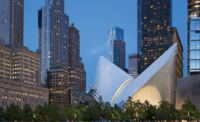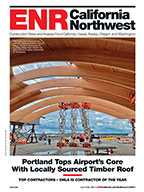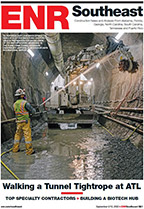 |
| SOARING Architects conceptual design of new transit hub includes two winged sections crisscrossing an arched roof. (Rendering courtesy of the Port Authority of New York & New Jersey) |
Construction could begin next year on components of a new multimodal transit center at the site of the World Trade Center in New York City, say engineers with the Downtown Design Partnership, a team led by the joint venture of local firms DMJM+Harris and STV Inc.
Team architect Santiago Calatrava on Jan. 22 unveiled his conceptual design for the Port Authority of New York & New Jerseys $2-billion hub. Explaining that he was inspired by the idea of a child releasing a bird and by the landmark nature of New York City structures, Calatravas station design calls for two wing-shaped sections of glass and steel rising about 150 ft above the ribbed-arch roof. The roof will retract to allow light into the structure, including sunbeams as they were on Sept. 11, 2001.
The sunlight will shine into a grand pavilion, a mezzanine level and eventually about 60 ft down to the track platforms for the Port Authority Trans-Hudson subway lines to New Jersey. Pedestrian tunnels will link the station with New York City Transit lines, including the planned Fulton Street Terminal two blocks away; ferry service and the World Financial Center. There will be room for a potential rail link to John F.Kennedy Airport.
|
Scott McIntyre, STV deputy project director for the project, estimates that the main pavilion will encompass about 30,000 sq ft and the concourse level 68,000 sq ft, comparable in scope to Grand Central Terminal.
The team now will work on refining the concepts of Calatravas design, says Margarita Gagliardi, STV senior vice president. That includes specifics of the retractable roof and other construction features. Tunneling likely will be cut-and-cover or open construction, says Herbert Spooner, DMJM+Harris project director. Design-build and other delivery methods are being explored.
Foundation work will be among the early construction challenges, particularly the existing slurry wall, removal of old underground structures and utility relocation, says a port authority official. Some construction could start by the end of the year, he says. Building the station alongside work on the Freedom Tower and memorial on a 16-acre site will be challenging in terms of coordination, officials agree. Emotionally, its not business as usual for us, says McIntyre. The station is expected to open in 2006.




Post a comment to this article
Report Abusive Comment